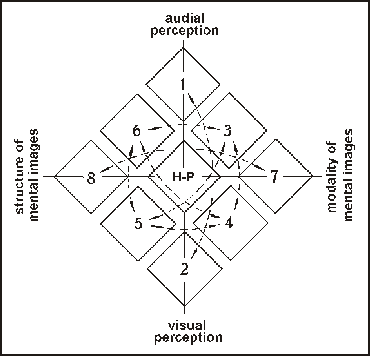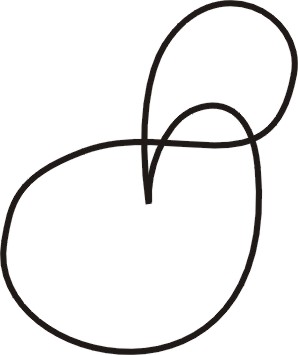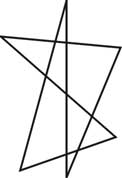The article concerns synaesthesia as one of the form of interaction in the
polysensorial form of perception. The author emphasizes the existence of normal
synaesthesia as "intersensational association" and manifestation of non-verbal
thinking connected with intersensational comparison. The synaesthesia is considered and
explained in its various manifestations: "general sense", "colour
hearing", etc. The author positively insists upon the general normality of the
synaesthetic human faculties. By his opinion, the possible deviations from this norm do
not relate to the art and science, just as it's being the case in any field of psychics.
Correspondingly, this concept discredit the myth that Scriabin and Kandinsky were certain
unique "synaesthetes" who actually heard colors and saw sounds. In these cases
we have dealt with just more fine and complicated metaphorical thinking, in which the
latent comparisons are formed (often by unconscious) between impressions of different
modalities.
The art researchers often run into the poetic revelations kind of "dawn-blue sound
of the flute" (Russian poet K.Balmont) or "thin, cutting whistle, like the
dazzlingly white thread, is winding round the throat" (Russian writer M. Gorky). Then,
Scriabin confessed that for him C-dur is of red colour; Kandinsky, as well as Balmont,
"tinctured" the timbres of musical instruments. While meeting these facts, the
researches "never noticed" that they dealt with the metaphor, though the unusual
one, connected with the intersensory transfer. Trying to understand these so called
synaesthesies, they drew in various explanations: physical analogy between light and sound
("both are the wave phenomena"); anatomic anomalies ("maybe, the nerve
fibres have got entangled"); atavism ("the relapse of the pristine
syncretism"); psychopathology, although useful in some sense ("the sound never
can be regarded as cutting or shining thing"); psychodelic dreams ("using drugs
leads to hallucinations and the sounds may actually become visible"); the miraculous,
esoteric feature of psychic ("it is open only to selected persons who have accepted
the mystery knowledge"). At any case, synesthesia and, in particular, "colour
hearing" was regarded as deviation from the norm - either positive or negative one.
This is the source of the common prejudices, which are revealed in encyclopaedic and even
academic editions: "Synaesthesia is the sensory system anomaly; such artists as
Rembaut, Baudler, Balmont, Block, Scriabin, RimskyKorsakov, Kandinsky, Messian suffered
from this (disease). In XX century the endeavours have become very popular to develop the
abstract painting and new sort of art, "colour music", on the basis of
synaesthesia (in its concrete form of "colour hearing")...". Such
prejudices are very stable both in Russian and Western science.
Actually, synaesthesia (at least in the case of the above mentioned artists) is no more
then intersensory association, often multi-level and systemic one; this is the
manifestation of the metaphoric thinking, which, as it is known, is based upon the
association mechanism. Even the "colour hearing" concept itself appears to be a
metaphor! But whereas the metaphor "girl - lily" is the comparison of
"visual to visual" type, the comparison of the girl with "Elegy" by
Massenet is of different, namely synaesthetic type. Metaphors, as it has been established
long ago, descends from "associations by resemblance". In the case of
synaesthesia this association is settled by the resemblance of the phenomena of different
modes. It looks like "the sense parallax" or, more precisely, the intersensory
transfer. The resemblance may be either in the content (meaning, emotional impression -
see the above cited Balmont's metaphor) or in the form (structure, Gestalt - see Gorky's
metaphor). The intersensory transfer, synaesthetic comparison, as any comparison "by
resemblance" is the operation of thinking! But in this case, the thinking proceeds,
so to say, within the frame of sensory-sensible sphere, that is, relates to the area of
non-verbal, sensiblefigurative thinking. The non-verbal thinking being more complicated in
this case than, for example, simply visual or musical thinking, because it realizes as the
connections in the whole multi-modal sensory system. This act of synaesthetic thinking
often takes place with the participation of subconsciousness (due to the coupling of
protopathic components of the senses related to different modes). In the light of
consciousness only the final result is seen, often being fixed in the word (like
"dawn-blue sound of the flute"), which imparts the element of mystery in
synaesthesia, thus causing the above mentioned prejudices of the "educated
knowledge".
...Now, after such an assaulting preamble, let us refer to history of science where
it appears that the concept of "general sense", close to that of
"synaesthesia" had been under consideration and discussion long ago, you know.
But again with no definite result. In terms of mysteriousness, the problem under our
review is close too to the dated from the 17th - 19th centuries mentions of the
out-of-aesthetic and especially naturalphilosophic juxtapositions of sound and colour as
of natural phenomena. In Newton's times these analogies had eventually taken the form of
the naive and preposterous idea of "music of colour", "music for eyes"
which were based on absurd attempts to translate from sound to colour. But it is these
scholastic ideas that had caused an attention to be paid to the purely "human"
now (i.e. psychic) correlations between aural phenomena and colour. And so, the exotic
term "colour hearing" came into being (in the end of 19th century). As noted
already above, "colour hearing" is particular manifestation of the more common
human faculty named "synaesthesia", being studied by us. And it is noteworthy
that "colour hearing" too was firstly analyzed by philosophers and theorists of
art rather than by psychologists.
Today there are some remnants of all this nomenclative discordance one can even trace
in the works of the scientists who seem to find the right interpretation of the phenomenon
itself. And in order the researchers "find common language" I should like to
give a warning of very variant understandings of limits of the concept of
"synaesthesia" being studied by us.
For example, by some researchers it involves only the phenomenon called "colour
hearing", by others - only that was formerly believed to be "general
sense". Some else confine oneself to positions of gestalt-psychology... I should like
to offer such common explanation of synaesthesia where will be room both for "general
sense" and for "colour hearing", and moreover for other manifestations of
this phenomenon. The major senses are seeing and hearing, therefore, it is upon
interconjunctions between those ones that it is convenient for us to base ourselves in
explaining.
So, determining consciousness, being determines also the initial level of it -
polysensory perception with all its morphological and functional particular qualities. In
this case, the functions determine, as usual, structure and thereby the system of
sensational reflection is ever a reflection of reality.
When speaking more simply organs of senses are kind of windows of consciousness. And
they have already been investigated in detail as a study of physiology and psychology. But
why are they just that what they are and five is a number of theirs? - with this question
rather philosophers than psychologists seems vexed their minds. Philosophers again keep
hard at deliberation on the question and about a potential existence of certain
"general sense" which either unites the others or operates its common
characteristics. It was called "Koinon aistherion" by Aristotle, while others
cogitated over "Sensorium commune", Gemeinsinn" (Kant, Herder, Engels,
etc). But this question could not have any rational solution on account of the
scholasticism of the old times - up to nowadays, when this epistemological problem has got
its psychological natural background.
Probably, a help to solve this problem is suggested by our theory of synaesthesia
studying the system interactions in the sphere of sensational reflection
[1].
For its compressed and capacious exposition we use a graphic method and, in this case,
based on well-known thesis: method is an analogue of subject (see Fig.1). The expedient
which underlies the method is "splitting" some essential faculties of human nature
which are under our consideration, that conforms the thesis: dividing of the single and
cognition of its contradictory aspects is a core of dialectics. Without some pretensions
to catholicity and completeness, the suggested diagram illustrates an object of our
interest - one section alone of holistic system. This section is plane and, accordingly,
the figure is a twodimensional system of axes, representing demonstratively the well-known
principle of binary opposition.
 Fig.1. System of multisensorial perception
Fig.1. System of multisensorial perception
So, let us place bisensory "homo-perceptor" (H-P) in the middle of this
system. The dichotomy "sight - hearing", which is of our primary interest, was
marked with the horizontal, when the elevation marks out for the dichotomy "form -
contents" reflecting the dialectics of subjective and objective aspects of
sensational reflection, which provides forming mental image in our consciousness. There
the "subjective" is a modality of mental image while "objective" is a
structure of mental image. Components put presciented and limbed from "H-P " to
every side are: 1 - the audial perception; 2 - the visual perception; 3
- the modality of hearing; 4 - the modality of sight; 5 - the structure
of visual perception; 6 - the structure of audial perception. Naturally, we are
on the supposition all these components belong with an action of the brain whose position
can conventionally be presented as the central cell embodied in "HP" and
consisted with one. As a matter of fact, the present schematic abstraction is not quite
conventional, it represents an integral act of sensational reflection which is really
differentiated by science between sensation and perception (more accurately, there is a
differentiation of the characters of reflection, those "primary" and
"secondary" qualities, by John Locke)
[2].
It is well-known, any system conserves its integrity owing to some cemented
conjunctions between subsystems. There are the conjunctions of "association"
type (in this case they are intersensorial), as we has already noted above, that are
called "synaesthesia". On the figure they are designated with dotted lines.
(And, of course, there exist other conjunctions, including the anomalous ones which result
in a deformed activity of the perceptual system, for example, the uncontrollable and real
"co-sensations" in LSD research or in sensory isolation, but that is not of
interest for art psychology and aesthetics.)
Actually, synaesthesias arise between components 1 and 2, but the multity of
synaesthesias includes those in which either primary or secondary qualities in some
conjunction can be accented. For example, such poetic tropes as "red call of
trumpet" or musical analogies "colour - timbre", "colouring -
harmony" (that is what was once called "colour hearing") are relevant to
the conjunctions 3-4. And, for example, such synaesthetic universals as
"melody - graphics", "music - architecture" or "music
-ornament" are relevant the conjunctions 5-6. Of course, cross-conjunctions
of 4-6 or 3-5 types are possible, too.
On our opinion, in the cell 7 belong so-called "intermodal
qualitats" - these are some common qualities of every sensation which characterize
its tonus (intensity, activity, saturation). In all events, behind the "intermodal
qualitats" stand some characteristics of quality and intensity of the sensations of
various modalities taken outside their structural formalization, mediated by unity of
their common affective tone. It is well-known that the words "bright - dark",
"hot - cold", "acute - blunt", "heavy - light", "hard -
soft" are used for emotions (feelings, moods) themselves, with that time, and also
for sounds (colours, smells, tastes). "Intermodal qualitats" underlie the most
universal synaesthesias. It is on these synaesthesias that such researchers as
E. Hornbostel [3]
and L. Marks [4]
make an emphasis.
To all appearances, in the cell 8 must belong characters, similar
to "intermodal qualitats", which unify structural characteristics of perception.
Upon these characters, in point of fact, gestalt-psychologists based themselves when had
stated possible existence of certain amodal "synthetical shape". It should seem,
their belief is substantiated by their prominent experiment with "tekete" and
"maluma" when, alas, there can not really exist any exact complete structural
similarity of phenomena of different modalities (see Fig. 2). However, the
"qualitats" 8 can be united by mentioned above characters "acute -
blunt", "soft - hard" etc., which makes the "intermodal
qualitats" 7 and 8 close together.
Fig. 2. What of these figures is "maluma" or
"tekete"? (Let us change the question: Where is "March" and where is
"Waltz" drawn here? Where is "Sword Dance" by Khachaturian and where
is "Elegy" by Massnet? I think that everybody will answer these question
identically.
On our opinion, it is an aggregate of these system "intermodal qualitats" 7
and 8 that constitutes an essentials of mysterious "Sensorium commune".
And if anybody do not agree with this conclusion, as the saying goes, "propose yours
own"... This conclusion fall, at least, within the submissions of Aristotle who
attributes to "koinon aistherion" explained in his work "De Anima"
just what we have in the cell 8 (although outside of this context, unity of
senses by the characteristics of the cell 7 is also specified by Aristotle). His was of
opinion that each of our senses has its own object. As for the general attributes he
believed in existence of "general sense". And the most principal thing according
to him is that cannot "be a special organ for the perception of the common
objects". They circumstantially perceive with every sense "movement, rest,
number, shape, size" [5].
And there is not contradiction between the
above conclusion and another standart-bearer of common sense, F.Engels. In
quot;Dialectics of nature" he arrives to a conclusion that intersensual associations
are necessarily formed on basis of an experience of collaboration of organs of senses, -
hereupon it is not necessary for human being "to have one "general sense"
instead of five specialized senses" or to have the ability for seeing or hearing
smells (to all appearance, both of suggestions are equally nonsensical for
him) [6].
There are no odd pages in the history of culture and on its new pages the content of
ancient ones comes before us in new appearance... On our opinion, such is a destiny of the
concept "general sense" closely related with that one of
"synaesthesia" which was actively studied recently and also with one of
"colour hearing" as the most exotic and subjective form of it. Correspondingly,
the explication of conception of "music of colour" ("music for eyes")
was represented differently today. But anyway that is the topic for another
discourse [7]
....
References:
- Galeyev B. Man, Art, Technology (the problem of synaesthesia
in the art). - Kazan, KGU Press, 1987 [in Russian]. Galeyev B. The problem of synaesthesia
in the arts. - Languages of Design, v.1, 1993, N 2, pp.201-203. Galeyev B. Synaesthesia
and musical space. - Leonardo, v.26, 1993, N 1, pp.76-78.
- Locke J. [1690] . An Essay Concerning Human Understanding. -
New York, Dutton, 1961.
- Hornbostel E. Die Einheit der Sinne - Melos, 1925, N 4,
SS.290-297.
- Marks L. The Unity of Senses: Interrelations of Modalities -
New York, Academic Press, 1978.
- Aristotle, cit. from the article: O. Neumaier Unity and Multiplicity of
the Senses.- In: Polyaisthesis (collection of the articles). Wien, 1991, p.42.
- K. Marx, F. Engels: Works, 2nd Edition. - Moscow, Politizdat,
p.548. [in Russian]
- Galeyev B. On the true sources of light-music. - Languages of
Design, v.3, 1995, N 1, pp.33-34.
Presented at the international conference
"Language, Vision & Music", Aug.1999, Ireland, Galeway.


